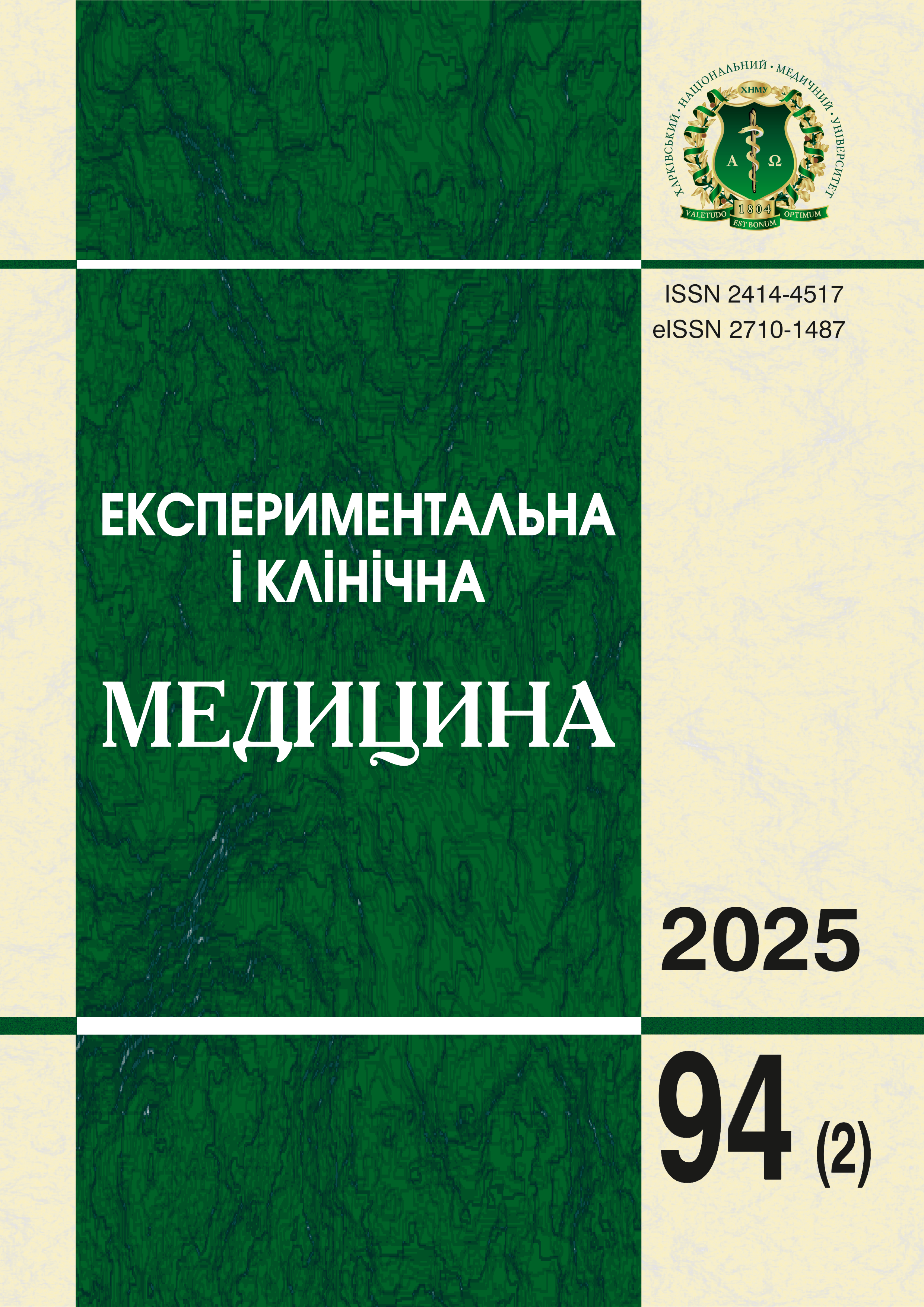Abstract
This study presents the results of a comprehensive clinical, instrumental, and biochemical investigation aimed at developing logistic regression-based mathematical models to predict the risk of developing cardiometabolic comorbidities in patients with arterial hypertension in combination with obesity (OB) and/or type 2 diabetes mellitus. The research included an in-depth evaluation of clinical parameters, laboratory markers, and echocardiographic indicators to identify independent predictors with significant diagnostic and prognostic value. Among the key predictors were the isovolumic Relaxation Time of the left ventricle, cardiotrophin-1 (CTF-1), cystatin C, neutrophil gelatinase-associated lipocalin, N-terminal pro-B-type natriuretic peptide, 25-hydroxyvitamin D (25(OH)D), the ratio of early to late diastolic filling velocities (VE/VA), body mass index, relative wall thickness of the left ventricle, right atrial area, glycated hemoglobin (HbA1c), catestatin concentration, glomerular filtration rate, and left atrial diameter. Based on these markers, several logistic regression equations were developed for stratifying the risk of developing obesity, type 2 diabetes, or combined comorbidity in patients with hypertension. These models demonstrated high predictive performance, with an Area Under the (ROC) Curve (AUC) exceeding 0.94, indicating excellent diagnostic accuracy. The practical implementation of these models enables clinicians to identify patients at high risk at earlier stages, tailor preventive and therapeutic interventions according to individual biomarker profiles, and improve long-term outcomes through more precise clinical monitoring. The proposed approach supports the broader integration of personalized medicine into internal medicine and cardiology, particularly in the context of managing complex cardiometabolic polymorbidity, and contributes to optimizing decision-making processes in everyday clinical practice.
Keywords: arterial hypertension, type 2 diabetes mellitus, obesity, biomarkers, prediction.
References
Pavlou DI, Paschou SA, Anagnostis P, Spartalis M, Spartalis E, Vryonidou A, et al. Hypertension in patients with type 2 diabetes mellitus: Targets and management. Maturitas. 2018;112:71-7. DOI: 10.1016/j.maturitas.2018.03.013. PMID: 29704920.
Teck J. Diabetes-Associated Comorbidities. Primary Care. 2022;49(2):275-86. DOI: 10.1016/j.pop.2021.11.004. PMID: 35595482.
Wang J, Liu F, Kong R, Han X. Association Between Globulin and Diabetic Nephropathy in Type2 Diabetes Mellitus Patients: A Cross-Sectional Study. Front Endocrinol (Lausanne). 2022;13:890273. DOI: 10.3389/fendo.2022.890273. PMID: 35898464.
Mavrogeni SI, Bacopoulou F, Markousis-Mavrogenis G, Chrousos G, Charmandari E. Cardiovascular Imaging in Obesity. Nutrients. 2021;13(3):744. DOI: 10.3390/nu13030744. PMID: 33652678.
Seravalle G, Grassi G. Obesity and hypertension. Pharmacol Res. 2017;122:1-7. DOI: 10.1016/j.phrs.2017.05.013. PMID: 28532816.
van Smeden M, Reitsma JB, Riley RD, Collins GS, Moons KG. Clinical prediction models: diagnosis versus prognosis. J Clin Epidemiol. 2021;132:142-5. DOI: 10.1016/j.jclinepi.2021.01.009. PMID: 33775387.
Karagiannidis E, Moysidis DV, Papazoglou AS, Panteris E, Deda O, Stalikas N, et al. Prognostic significance of metabolomic biomarkers in patients with diabetes mellitus and coronary artery disease. Cardiovasc Diabetol. 2022;21(1):70. DOI: 10.1186/s12933-022-01494-9. PMID: 35525960.
Kumric M, Ticicnovic Kurir T, Borovac JA, Bozic J. Role of novel biomarkers in diabetic cardiomyopathy. World J Diabetes. 2021 Jun 15;12(6):685-705. DOI: 10.4239/wjd.v12.i6.685. PMID: 34168722.
Hogas S, Bilha SC, Branisteanu D, Hogas M, Gaipov A, Kanbay M, et al. Potential novel biomarkers of cardiovascular dysfunction and disease: cardiotrophin-1, adipokines and galectin-3. Arch Med Sci. 2017;13(4):897-913. DOI: 10.5114/aoms.2016.58664. PMID: 28721158.
Szymanek-Pasternak A, Marchewka Z, Szymanska B, Filipowski H, Dlugosz, et al. Assessment of the usefulness of β2-microglobulin and retinol binding protein for the purpose of testing kidney function in HIV-positive patients. HIV AIDS Rev. 2014;13(2):40-5. DOI: 10.1016/j.hivar.2014.02.006.
Pankova OA, Korzh OM. The significance of catestatin and relaxin-2 in the diagnosis of myocardial remodeling in patients with essential hypertension and type 2 diabetes mellitus. Ukrainskyi terapevtychnyi zhurnal. 2023;(4):24-32. DOI: 10.30978/UTJ2023-4-24. [In Ukrainian].
Zoppini G, Bergamini C, Trombetta M, Mantovani A, Targher G, Tolini A, et al. Echocardiographic parameters according to insulin dose in young patients affected by type 1 diabetes. PLoS One. 2020;15(12):e0244483. DOI: 10.1371/journal.pone.0244483. PMID: 33370380.
Parcha V, Patel N, Kalra R, Suri S, Arora G, Wang TJ, et al. Obesity and serial NT-proBNP levels in guided medical therapy for heart failure with reduced ejection fraction: Insights from the GUIDE-IT trial. J Am Heart Assoc. 2021;10(7):e018689. DOI: 10.1161/JAHA.120.01868.
Malachias MVB, Jhund PS, Claggett BL, Wikman MD, Lewis B, Chaturvedi N, et al. NT-proBNP by itself predicts death and cardiovascular events in high-risk patients with type 2 diabetes mellitus. J Am Heart Assoc. 2020;9(19):e017462. DOI: 10.1161/JAHA.120.017462
Jayedi A, Daneshvar M, Jibril AT, Sluyter JD, Waterhouse M, Romero BD, et al. Serum 25(OH)D concentration, vitamin D supplementation, and risk of cardiovascular disease and mortality in patients with type 2 diabetes or prediabetes: a systematic review and dose-response meta-analysis. Am J Clin Nutr. 2023;118(3):691-707. DOI: 10.1016/j.ajcnut.2023.07012.

This work is licensed under a Creative Commons Attribution-NonCommercial-ShareAlike 4.0 International License.

